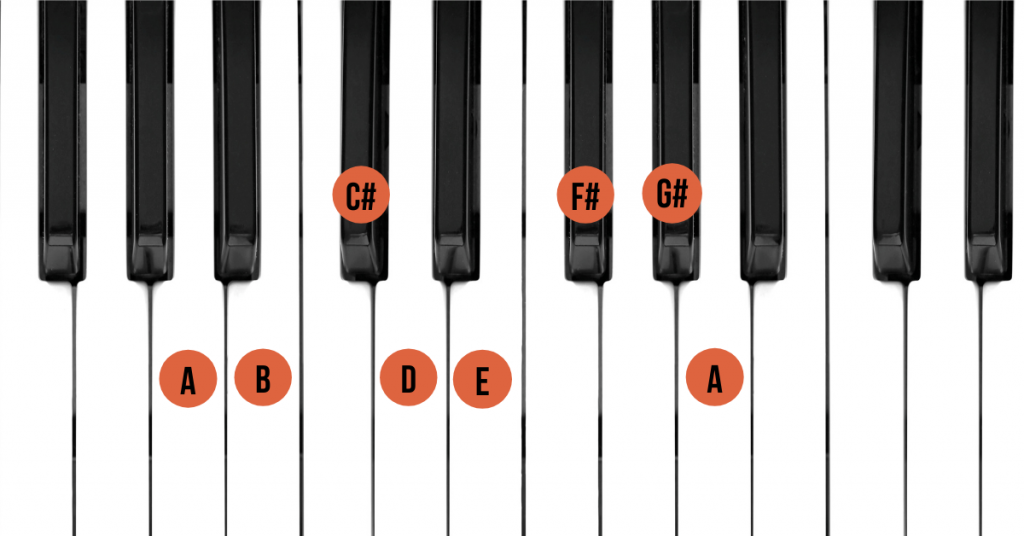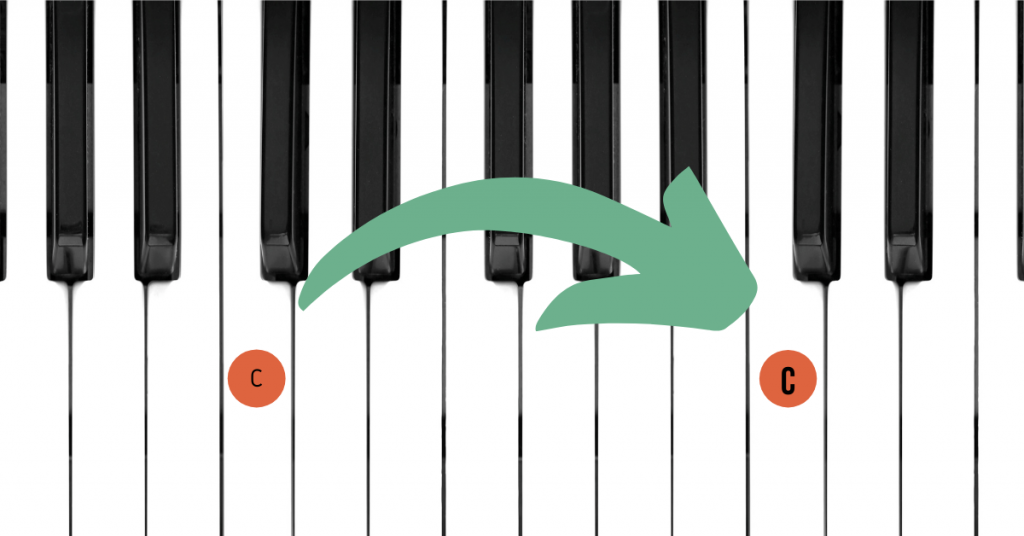The major scales are the building blocks of western music. The major scale is the “roadmap,” which can make up chords and melodies.
In this blog post, we’ll go over major scales in a songwriter-friendly way.
You’ll discover:
- How major scales work
- The formula to play in any key signature
- How to communicate notes in any key signature using numbers
- How to build chords in any key
- And much more…
Let’s jump in!
What are Music Scales?
A scale is a sequence of notes ordered by pitch. Thus, scales are the “framework” you use to build musical melodies and chord progressions for your song.
There are many different types of scales in music theory; however, the major scale is the “king” of western music.
What is a Major Scale?
Major scales are recognized as the fundamental scale in Western music.
It’s punchy and stable by nature, which lends itself to creating happy-sounding melodies and chords.
The major scale is the most important scale to learn as a songwriter.
As a songwriter, you will generally write in major scales. However, if you want to expand your sonic toolbox with more complex sounds, understanding the major scale will be crucial to your learning.
Major scales will also help you understand:
- Intervals
- Key Signatures
- Minor Scales
- Pentatonic Scales
- Bebop Scales
- Modes
- Chords
- Chord Progressions
Major Scale Intervals
Intervals are the amount of space between notes. Intervals are what give a scale its tonal characteristics.
The intervals in a scale will not change no matter what key signature you are playing in.
If you memorize the scales intervals, then you can play in any key.
Semi-Tones
Semi-tones are the shortest distance between any note. You can also refer to these as half-steps.
Tones
A tone = two semi-tones. It can also be called a whole tone or whole steps.
Major Scale Formula
The Major Scale is broken down into the following intervals:
- Whole Step
- Whole Step
- Half Step
- Whole Step
- Whole Step
- Whole Step
- Half Step

Major Scales in Music
Now that we have a good understanding of the structure of the major scale, we can start to use it for writing songs.
Melody Writing
Writing melodies with a major scale is straightforward. All notes will work as long as you stay within the notes of the major key signature you are playing in.
Now it’s important to clarify that all notes will work, but not all will be the best choice.
Utilizing the pentatonic scale (five-note scale popular with guitar writing) to write melodies will give you the greatest chance of success for excellent note selection over any chord in the Major Scale.
If you want to learn more about pentatonic scales, I wrote an entire article on them to check out here.
Also, if you want to learn more about writing better melodies, you can read my article on the subject here.
Building Chords with Major Keys
A chord in music is a combination of three or more notes played together.
The most common chord type is called a Triad. A triad is a chord built with three notes from the scale you’re playing.
Chords can be major chords, minor chords, augmented chords, diminished chords, and suspended chords.
Chord theory is quite complex, and for the scope of this article, we will stick with the three most common chord types from the Major Scale.
- Major
- Minor
- Diminished
Each note has a chord associated with it that will either be Major, Minor or Diminished in the major scale.
If we are playing in the C Major Scale (all white keys on piano), then the chords would be:
- C Major
- D Minor
- E Minor
- F Major
- G Major
- A Minor
- B Diminished
No matter what major key you are playing, the fundamental chord types will not change.
Major Chords
The major chord triad in the major scale consists of a major third and major fifth.
For example, in b major, the major chords would be:
B Major

E Major

F# Major

Minor Chords
The minor chord triad in a major scale consists of a minor third and major fifth.
For example, in the F major scale, the minor chords would be:
G Minor

A Minor

D Minor

Diminished Chords
A diminished chord triad in the major scale will consist of a minor third and diminished 5th.
For example, in the G Major Scale, the diminished chord would be:
F# Diminished

Nashville Numbers
Nashville Numbers are a simple way of communicating major scale notes and chords in music.
It is an excellent system because you don’t need to memorize every note in every major key. Instead, you simply remember a number associated with the scale degree. Then, you can use that number to communicate for each key!
An example of the Nashville Number system in the C Major Scale (with scale degrees) would be:
C = 1 (1st scale degree)
D = 2 (2nd scale degree)
E = 3 (3rd scale degree)
F = 4 (4th scale degree)
G = 5 (5th scale degree)
A = 6 (6th scale degree)
B = 7 (7th scale degree)
You can use Nashville Numbers to communicate chords in the major scale as well. To use the key signature of C Major as an example:
C Major = 1
D Minor = 2
E Minor – 3
F Major = 4
G Major = 5
B Minor = 6
B Diminished = 7
Major Scale vs. Ionian Mode
As you dive deeper into music theory, you will come across a thing called modes. Modes are derived from a scale like the major scale. However, the modes have different intervals from their corresponding scale, creating a much different sonic “color.”
There is one mode called the Ionian mode. This mode is exactly the same thing as the Major Scale.
If you hear someone talking about the Ionian mode, you can interpret it the same as them talking about the Major Scale.
If you want to learn more about modes, I’ve written an entire article explaining the 7 Music Modes of the Major Scale that you can check out here!
Major Scale vs. Major Key
You might be wondering what the difference is between a major scale and a major key. The answer is not much.
A scale is defined by the intervals of the notes being played, while the key is a specific note that makes up the starting position (tonic) of the scale.
Major Scale vs. Diatonic Scale
A diatonic scale is made up of 7 different notes and an octave note. There are also 5 whole steps and 2 half steps.
Major scales fit the definition of a diatonic scale.
Major Scale = Diatonic Scale
Can a Major Scale Only Sound Happy?
No. A Major Scale can sound sad if you use the Minor Keys associated with it. Experiment and see what you can come up with!
The Notes of the 12 Major Scales
C Major Scale
C D E F G A B C

Db/C# Major Scale
Db/C# Eb/D# F/E# Gb/F# Ab/G# Bb/A# C/B# Db/C#

D Major Scale
D E F# G A B C# D

Eb Major Scale
Eb F G Ab Bb C D Eb

E Major Scale
E F# G# A B C# D# E

F Major Scale
F G A Bb C D E F

Gb/F# Major Scale
Gb/F# Ab/G# Bb/A# Cb/B Db/C# Eb/D# F/E# Gb/F#

G Major Scale
G A B C D E F# G

Ab Major Scale
Ab Bb C Db Eb F G Ab

A Major Scale
A B C# D E F# G# A

Bb Major Scale
Bb C D Eb F G A Bb

B/Cb Major Scale
B/Cb C#/Db D#/Eb E/Fb F#/Gb G#/Ab A#/Bb B/Cb

Enharmonic Scales
From the above list, you might notice that we grouped some scales together. These scales are called enharmonic scales, and they share the same notes but have different names.
You are not alone if you find this confusing and challenging to know when to choose between sharps or flats.
Choosing between sharps or flats will depend on the context of what you are writing.
For most pop songwriting applications, you will not have to worry about the distinction.
You may also notice that we left some key signatures out of the list. For example, G#.
G# is a key signature; however, it’s very impractical and complicated because it has double sharps. Therefore, it makes more sense to use its enharmonic equivalent, Ab Major, instead.
Major Scale Terminology
When you jump into learning the theory behind the music you create, you will be bombarded with some jargon that can quickly become confusing.
I wanted to give you a simple terminology guide to help you read through theory concepts quickly.
Scale Degree = The position of the note within the major scale. For example, B is the seventh scale degree in the C major scale.
Sharp (#) = When you raise a note by a half step
Flat (b) = When you lower a note by a half step
Tonic = The first note in the scale
Octave = The same note at a higher scale degree

What to do next?
As you can see, the major scale is crucial knowledge for better songwriting decisions.
Once you understand the basic interval formula and Nashville Number system, writing in any key signature becomes a breeze.
Learning all the notes within each key is wise, but it isn’t necessary to write great songs.
Take what you learned today and apply it to your songwriting. Instead of thinking of theory as a restrictive factor to your music, think of it as a roadmap to making more informed melodic decisions.
Please read my “how to write a song” guide here to learn more about writing a song from scratch!

